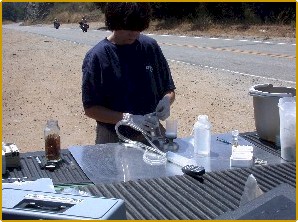|
BOB SIMONSON, Program Leader
QUANTIFYING FECAL COLIFORMS - ECOLI IN THE FIELD Kim Clarkin , Project Leader |
||

San Dimas Technology
& Development Center
444 E Bonita Ave
San Dimas, CA 91773
(909) 599-1267
| Incubators | QA/QC | Batteries & Inverters |
Project Summary Current EPA-approved methods for analyzing lake and stream coliform samples limit holding time to only eight hours before processing. In the back country, it is sometimes impossible to send samples to a laboratory within the specified time, and an in-field analysis is necessary in those situations. The goal of this project was to assess available methods and equipment for use in the field.
We developed prototypes of two portable analysis kits--one for fecal coliforms and one for E. coli--that enable the complete cycle of sample processing, incubation and colony counting to be completed in remote areas. The kits can be powered by the vehicle battery, battery packs, deep cycle marine batteries, or a combination. Kit components include sterile disposables and other equipment from the Hach and Millipore companies, an incubator, and in the case of the E. coli kit, a sealer for the IDEXX Quanti-trays.
In our field tests, the E. coli kit produced results comparable to a certified lab using the same method. However, when the fecal coliform test was performed immediately after sample collection, it tended to show fewer colonies than tests conducted a few hours later in the lab. We do not believe the problem lies with the kit (see Fecal Results
This page is organized by test organism - either fecal coliforms or E. coli. Fecal coliforms can only be analyzed using the membrane filtration method. E. coli can be done by membrane filtration too, although it is easier using a multiple well enzyme substrate test. For each organism, we outline the methods and equipment used in the kits, and our test results for various kit components. We also provide the kit equipment list as well as plans for kit containers that can be carried in a van or a truck.

Filtering a water sample for fecal coliform analysis
- http://standardmethods.org- Standard Methods for the Examination of Water and Wastewater online- requires subscription or fee to use.
-
http://www.epa.gov/owow/monitoring/index.html- The US EPA's guide to monitoring and assessing water quality, including information on volunteer programs.
http://water.usgs.gov/pubs/twri/twri5a4/- The USGS guidelines for various methods. Sections 1, 2, and 3 are most relevant to coliforms.
-
http://www.epa.gov/fedrgstr/EPA-WATER/2003/July/Day-21/- EPA ambient water rule listing approved tests for bacteria in surface waters.
Methods and requirements:
- http://www.hach.com- The Hach corporation, which can provide materials and kits for membrane filtration.
- http://www.millipore.com- The Millipore corporation, which also provides MF equipment and media. Note that you must register at the site before pricing information will be made available.
- http://www.idexx.com- The Idexx company, a source of materials for the enzymatic substrate test. Call for pricing information.
- http://www.micrologylabs.com- Makers of Coliscan Easygel and related equipment. Please note that Coliscan products are approved for drinking water monitoring only, and cannot be used for surface waters outside of EPA Region 4.
- http://www.pall.com- The Pall Corporation website- makers of disposable filter/petri dish assemblages for membrane filtration.
-
http://www.3m.com- 3M corporation, makers of Petrifilm.
Materials and equipment:
-
http://www.csupomona.edu/%7Ebiology/index.html- Cal Poly Pomona's biology department.
-
http://www.dmalabs.com- Del Mar labs in Southern California.
External labs that we have used:
General information:


